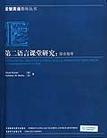第二语言课堂研究
出版时间:2010-1 出版社:外语教研 作者:(澳)纽南//(美)贝利 页数:496
Tag标签:无
前言
We wrote this book with the intention of providing an introduction toresearch in second and foreign language classrooms. It grew out ofcourses and workshops on classroom research that we have devel-oped and taught for teachers conferences and graduate programs in applied lin-guistics. We aim to provide an introduction to language classroom research thatis accessible to readers who do not necessarily have specialist training in researchmethods. The book has two overriding objectives. The first is to provide an overviewof and introduction to language classroom research. To this end, we look at bothsubstantive issues (that is, the topics and questions that have been investigated byclassroom researchers) and methodologica! issues (the techniques and methodsthat researchers have employed for collecting data, interpreting the data, andpresenting the results). The second obieetive is to help readers devdop practicalskills for carrying out original empirical investigations. Although the context ofthe book is the second language classroom, our intention has been to cover con-cepts and techniques that will be broadly applicable to a wide range of appliedlinguistics contexts.
内容概要
“圣智英语教师丛书”精选自圣智学习出版公司出版的当代语言教育领域的力作,由当今国际语言教育界的权威人士编著,国内英语教育界专家、学者撰写导读。丛书选题涵盖外语教学理论、语言教学技能和实践、学法指导、课程设计、语言测试与评估、外语教学科研方法、师资发展、语境和文化教学以及教学法等诸多领域,能够满足目前英语教师适应新课改的迫切需要。本丛书既可用作英语教师专业化教育与发展和英语专业硕士研究生教育的教材,同时也是语言教育研究者必备的参考书。
书籍目录
Preface
《第二语言课堂研究:综合指导》导读
PART I SECOND LANGUAGE CLASSROOM RESEARCH: AN OVERVIEW
Chapter 1 Introducing Second Language Classroom Research
Chapter 2 Getting Started on Classroom Research
Chapter 3 Key Concepts in Planning Classroom Research
PART II RESEARCH DESIGN ISSUES: APPROACHES TO PLANNING AND
IMPLEMENTING CLASSROOM RESEARCH
Chapter 4 The Experimental Method
Chapter 5 Surveys
Chapter 6 Case Study Research
Chapter 7 Ethnography
Chapter 8 Action Research
PART III DATA COLLECTION ISSUES: GETTING THE INFORMATION YOU
NEED
Chapter 9 Classroom Observation
Chapter 10 Introspective Methods of Data Collection
Chapter 11 Elicitation Procedures
PART IV DATA ANALYSIS AND INTERPRETATION ISSUES: FIGURING OUT WHAT
THE INFORMATION MEANS
Chapter 12 Analyzing Classroom Interaction
Chapter 13 Quantitative Data Analysis
Chapter 14 Qualitative Data Analysis
Chapter 15 Putting It All Together
References
Index
Text Credits
章节摘录
最早采用心理测量法进行的语言课堂研究是由Scherei&Wertheimer(1964)开展的。这是一项典型的“教法比较”研究,旨在比较“语法一翻译法”和当时兴盛的“听说法”。研究问题是:用“听说法”教授外语是否比“语法一翻译法”更加有效。但两年的实验未能证明其中一种教学法优于另一种,因为“语法一翻译法”组的学生阅读和翻译成绩明显好于“听说法”组的学生,而“听说法”组的学生在听力和口语测试中则表现更加出色。 该研究受到的批评之一是没有调查语言课堂上真正发生了什么。他们仅仅假定教师按照某种方法去教,但没有收集相关的数据;关于教师对所用方法的理解也缺乏数据。这种做法被认为是对“黑匣子”研究的缺失,即人们无法知道课堂过程内部发生的实际情况,因此被称为“结果研究”(侧重考试成绩)。 与此相对应的是基于课堂的“过程研究”,其侧重点是教与学的课堂过程,而不试图用任何方法去测量学习结果。这种研究意在了解课堂(“黑匣子”)中发生了什么,而不是证明某种教法或课程比另一种的教学效果更好。 Swaffar,Arens&:Morgan(1982)开展的一项教法对比研究真正包含了对“黑匣子”的研究。研究旨在对比两种教学方法——“听说法”和“认知法”对德语学习者的有效性,但在研究设计上,Swaffar等坚信从课堂收集的“过程”数据和以考试成绩显示的“结果”数据同样重要。因此,他们的研究报告后来被称为“过程一结果研究”的范例(Long,1984)。 对“结果研究”、“过程研究”和“过程一结果研究”的讨论确实带来了课堂实证研究的发展;越来越多的人意识到将过程数据和结果数据融合在课堂研究设计中是很有价值的。
图书封面
图书标签Tags
无
评论、评分、阅读与下载
用户评论 (总计6条)
- 好。发货快。
- 书的质量很好 老师推荐买的书终于收到了
- 书不错,价格也还好。
- 快递挺快的,包装也 好着那 ,不过 居然 把 我的名字写错了。。
- 这本教材还好
- 实用性好,理念新颖
推荐图书
- 果树伴随生长整形修剪法
- 戰國思想史研究
- 儒教社会と母性(増補版)
- 旅游企业会计
- 近代中国の政治文化:民権・立憲・皇権
- 中国文明論集
- 静夜之时
- 中国古代の田制と邑制
- 四年级
- 名师教你学英语名师课堂·7年级英语
- 新课标考点大观
- 前漢政治史研究
- 西夏法典初探
- 学电脑安全与病毒防范
- 人文淮安(套装上下册)
- Chill: 100 Tips to Relax (精装)
- 白川静著作集 第8巻 古代の文学
- 白川静著作集 第1巻 漢字 I
- 白川静著作集 第2巻 漢字 II
- 涙星 1
- 白川静著作集 第3巻 漢字 III
- 白川静著作集 第4巻 甲骨文と殷史
- 特种兵
- 白川静著作集 第5巻 金文と経典
- 2010 口腔颌面外科学精选模拟习题集
相关图书
- 左傳の史料批判的研究
- Fair Juno (平装)
- 隋唐世界帝国の形成
- 北魏胡族体制論
- 北魏佛教造像史の研究
- 秦漢刑罰体系の研究
- 秦漢刑法研究
- 秦漢における監察制度の研究
- 日本饲养标准肉用牛
- 西嶋定生東アジア史論集:第一巻 · 中国古代帝国の秩序構造と農業
- 2005-专利复审和无效审查决定选编-全二册
- 幼儿智慧活动课程(大班下册)
- 多功能英汉词典
- 现代英汉双解词典
- 安徒生童话故事
- A Brief History of Life in Victorian Britain (平装)
- Hellfire (精装)
- 說YES的男人
- 二年级数学
- 小学生素质教育必备丛书·天赋之门阶梯阅读读本
- (2下)(2下)
- 时代智囊·爱学堂家庭教室(2年级下)
- 海瑞报恩
- 包拯审案
- 西嶋定生 東アジア史論集:第2巻 · 秦漢帝国の時代
